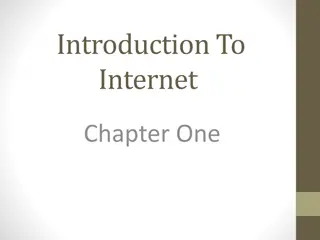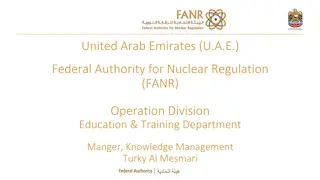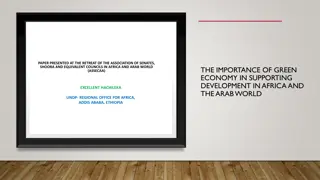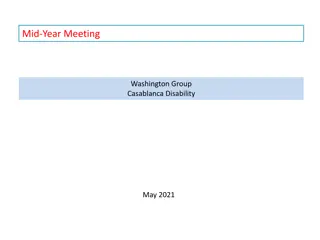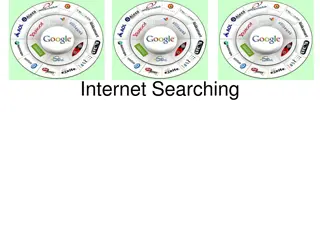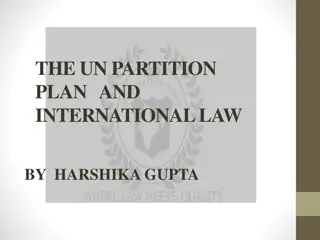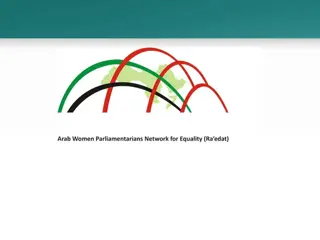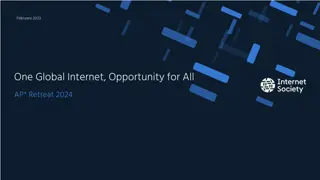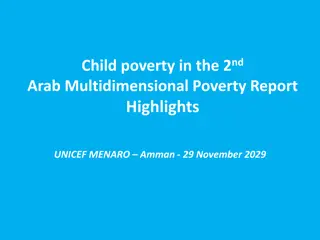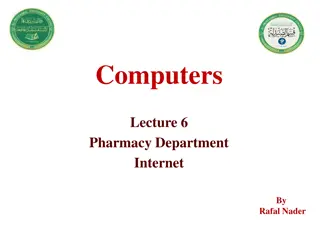Internet Overview in the Arab Region by ARISPA
The Arab Internet & Telecom Union (ARISPA) provides a detailed overview of internet penetration rates in the Arab region, focusing on global and regional comparisons, as well as the future IPv4 situation. Founded in 2006, ARISPA works under the Arab Economic Union Council, with 20 members representing 10 Arab countries. The organization aims to support Arab internet and telecom companies to enhance internet usage and penetration rates in the region.
Download Presentation

Please find below an Image/Link to download the presentation.
The content on the website is provided AS IS for your information and personal use only. It may not be sold, licensed, or shared on other websites without obtaining consent from the author. Download presentation by click this link. If you encounter any issues during the download, it is possible that the publisher has removed the file from their server.
E N D
Presentation Transcript
OVERVIEW ON THE INTERNET IN THE ARAB REGION M Feras Bakkour CEO Arab internet & Telecom Union ( ARISPA)
CONTENT ARISPA in brief Global and Regional Overview Internet Penetration Rates 2015 Levant Countries - Internet P.R 2000 2015 Comparison Levant vs Arab States Allocated IPV4 2015 IPV4 Future situation What can ARISPA do to help? Conclusion 2
THE ARAB INTERNET & TELECOM UNION (ARISPA) An International Organization None for Profit Founded in 2006 by 10 ISPs representing 8 Arab Countries. Working under the umbrella of the Arab Economic Union Council The League of Arab States General Secretariat office was registered in Manama Kingdome of Bahrain 2006. Then Moved to Beirut Lebanon in 2015 Members as of 2015 : 20 members representing 10 Arab countries Membership is open to all Arab Internet and Telecom companies. 3
ARISPA MEMBERS 2015 Country Members United Arab Emirates Syrian Arab Republic Lebanon Hashemite Kingdome of Jordan Kingdome of Saudi Arabia Egypt State of Kuwait Kingdome of Bahrain Sultanate of Oman 4
INTERNET USAGE & PENETRATION RATES (GLOBAL OVERVIEW) Global numbers of individuals using the Internet, total and per 100 inhabitants, 2001-2015 3,500 100 3,174 90 2,937 3,000 2,705 80 2,494 2,500 70 2,224 2,019 Per 100 inhabitants 60 millions 2,000 1,751 40.6 1,561 50 43.4 37.8 1,365 35.2 1,500 31.8 40 1,151 29.2 1,024 25.6 914 23.1 30 20.6 1,000 785 17.6 677 15.8 20 495 14.0 12.0 11.0 500 8.0 10 0 0 2001 2002 2003 2004 2005 2006 2007 2008 2009 2010 2011 2012 2013 2014 2015* Individuals using the Internet (in millions) Individuals using the Internet per 100 inhabitants Note: * Estimate Source: ITU World Telecommunication /ICT Indicators database 5
INTERNET PENETRATION RATES 2015 (GLOBAL OVERVIEW) INDIVIDUALS USING THE INTERNET PER 100 INHABITANTS, 2015* 77.6 80 66.0 70 59.9 60 50 43.4 37.0 36.9 40 30 20.7 20 10 0 Europe The Americas CIS** Arab States World Asia & Pacific Africa Regions are based on the ITU BDT Regions, see: http://www.itu.int/en/ITU-D/Statistics/Pages/definitions/regions.aspx.html Note: * Estimate ** Commonwealth of Independent States Source: ITU World Telecommunication /ICT Indicators database 6
INTERNET PENETRATION RATES (LEVANT COUNTRIES) Individuals using the internet in the Levant countries per 100 inhabitants as of 2015 90.00 82.46 74.70 80.00 70.00 57.74 60.00 53.67 48.20 50.00 44.00 40.00 29.94 28.09 30.00 20.00 13.50 11.30 10.00 0.00 2000 2001 2002 2003 2004 2005 2006 2007 2008 2009 2010 2011 2012 2013 2014 2015* Note: * Estimate Source: ITU World Telecommunication /ICT Indicators database Iraq Jordan Lebanon Palestine Syria 7
INTERNET PENETRATION RATES 2015 (COMPARISON) 90.0 82.5 80.0 70.0 57.7 60.0 48.2 50.0 43.4 37.0 40.0 29.9 30.0 20.0 13.5 10.0 0.0 Lebanon Jordan Iraq Arab States World Syria Palestine 8
ALLOCATED IPV4 IP`S 2015 IPV4 1000000 907264 900000 800000 661504 700000 641536 590080 600000 539648 500000 400000 300000 200000 100000 0 Iraq Jordan Lebanon Palestine Syria 9
IPV4 THE LAST OIL DROP !! Internet subscriptions are growing; More ISP`s are entering the market; More services are being implemented; RESULTING IN; HUGE CONTINOUS DEMAND of IPs, while we are facing SHORTAGE in SUPPLY IPV4 Demand IPV4 Supply 10
OPTIONS AVAILABLE Short Term Options; 1) Buying new IPV4 addresses from other LIRs; 1) High cost ( around 8 $ /IP or even more ) 2) Leasing IPV4 addresses from other LIRs; 1) High annual cost ( X $ ), and RISK 3) Go through an endless growing NATING loop; 1) Limited Validity Solution 11
OPTIONS AVAILABLE LONG Term Options; MOVING TO IPV6; MOVING TO IPV6; MOVING TO IPV6; MOVING TO IPV6; MOVING TO IPV6; MOVING TO IPV6; MOVING TO IPV6; 12
OPTIONS AVAILABLE EVEN BOTH !!! PAY the HIGH COST of staying with IPV4 Then .. discover .that you have to; MOVE TO OPTION 2 13
THE CASE.. The QUESTION is no longer WHY should we move to IPV6? But became, WHEN shall we start? 14
HOW CAN ARISPA HELP AND SUPPORT? ARISPA can play a supportive role to help and support members during the transition phase in several ways; Provide the needed consultancies and best practices to guide the transition. Provide the needed expertise to supervise and manage the migration. Coordinate among members to share the IP resources available within ARISPA members pool according to a certain agreement. Negotiate the best terms and conditions with the vendors to provide the members with the required services during the transition phase. Always coordinate and cooperate with the RIPE NCC to facilitate this transition. 15
CONCLUSION Internet subscriptions to reach 5 Billions in 2020. Moving to IPV6 is a MUST. Better NOW than Later. Investing in deploying IPV6 and cover the cost from the IPV4 high selling prices. ARISPA and Ripe NCC, are here to help and support .. ..USE US. 16
THANK YOU ferasbakour@arispa.net www.arispa.net





